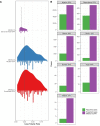Lassa fever cases suffer from severe underreporting based on reported fatalities
- PMID: 36413115
- PMCID: PMC10472868
- DOI: 10.1093/inthealth/ihac076
Lassa fever cases suffer from severe underreporting based on reported fatalities
Abstract
Background: Lassa fever is a viral haemorrhagic fever endemic to eight West African countries. Symptomatic disease is expected to occur in 20% of those infected and transmission typically occurs from viral spillover from rodent hosts. The combination of limited access to diagnostics and healthcare means the true burden of this disease is unknown.
Methods: The case fatality rate among confirmed, probable and possible cases of Lassa fever in endemic regions is expected to be ≈15%. Here, annual reported cases and deaths have been used to estimate the case fatality rate, using three subsets of available data, to understand the scale of underreporting of severe human cases.
Results: The literature review produced 38 records of cases and fatalities, comprising 5230 reported cases and 1482 reported deaths in seven countries. The estimated case fatality rate ranges from 16.5 to 25.6% (standard deviation 11.5-32.2). The expected number of severe cases between 2012 and 2022 is 8995, with current reported numbers 58% of what is expected.
Conclusion: This analysis highlights current uncertainty and systemic underreporting of the morbidity and mortality burden of Lassa fever in its endemic region and must be considered when discussing the epidemiology of this neglected tropical disease.
© The Author(s) 2022. Published by Oxford University Press on behalf of Royal Society of Tropical Medicine and Hygiene.
Conflict of interest statement
None declared.
Figures

References
Publication types
MeSH terms
Grants and funding
LinkOut - more resources
Full Text Sources

